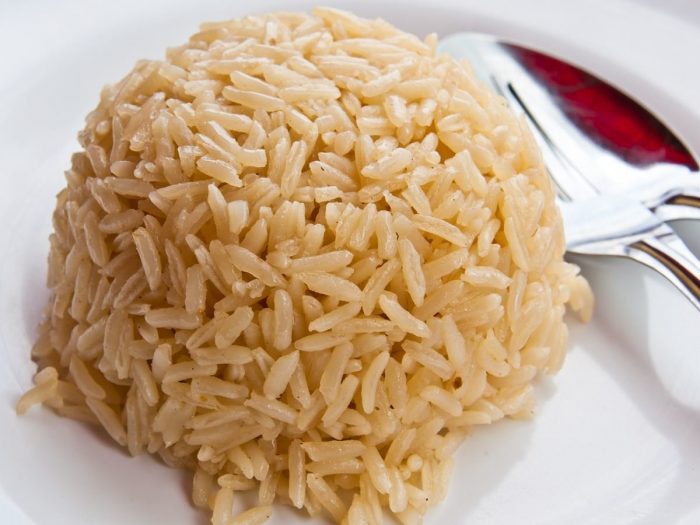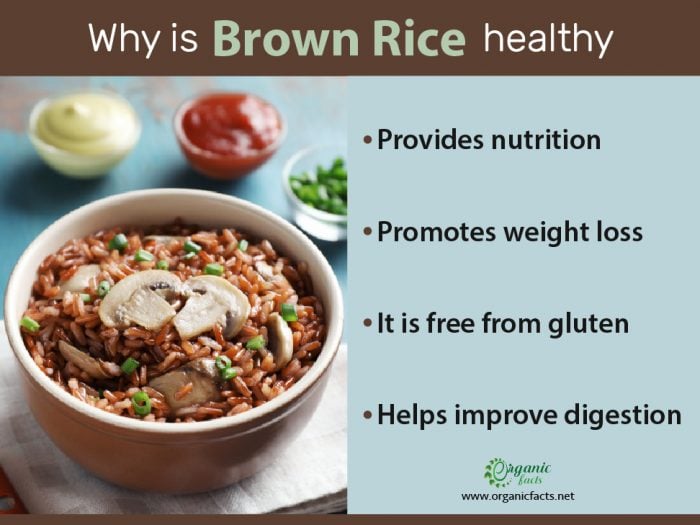Brown rice is a super whole grain which might be packed with a high degree of healthy components. The health benefits have been attributed to the high nutritional content, which may prove helpful against several conditions such as obesity, diabetes, digestion, and heart issues.
What is Brown Rice?
Brown rice is an unrefined, unpolished whole grain produced by removing the surrounding hull of the rice kernel. The grain retains its nutrient-dense bran and germ layer. It is chewier as compared with white rice and has a nutty flavor. [1]
Research published in the American Eurasian Journal of Agronomy [2] points out the benefits of including brown rice is more robust in the diet. It also suggests that it is comparatively healthier than white rice when it comes to nutritional value.
Germinated Brown Rice
Germinated brown rice, also known as ‘sprouted brown rice’, may be a healthier version which can be prepared at home. It can be stored in dried form to increase its shelf life without affecting its advanced nutritional worth. [3]
The high nourishing content of the germinated version is considered to be due to the presence of gamma-aminobutyric acid (GABA). The germinated form can be obtained by soaking and sprouting of the brown rice in water for a specified number of hours. This method has been considered best for obtaining the maximum amount of GABA and elevating the levels of proteins and beneficial enzymes in the germinated variety.
The process of germination also leads to a significant increase in essential components such as ferulic acid, lysine, magnesium, potassium, vitamin E, niacin, vitamin B 6, thiamine, and dietary fiber. These nutrients are thought to contribute to better absorption during digestion and prevent intestinal irritation, inflammation, and allergies.
Why Eat Brown Rice?
When compared to white rice, it is considered to be healthier and more nutrient-rich. Some of the stands out attributes may be the quality and quantity of nutrients it offers. The process of milling that converts the brown grain into white rice strips away most of its nutritional value. It thus retains the immense treasure of healthful constituents. There are many varieties available in the market with their unique flavor, aromatic components, and varied concentration of fatty acids.
| Serving Size : | |
|---|---|
| Nutrient | Value |
| Water [g] | 70.27 |
| Energy | 123 |
| Energy [kJ] | 514 |
| Protein [g] | 2.74 |
| Total lipid (fat) [g] | 0.97 |
| Ash [g] | 0.44 |
| Carbohydrate, by difference [g] | 25.58 |
| Fiber, total dietary [g] | 1.6 |
| Sugars, total including NLEA [g] | 0.24 |
| Sucrose [g] | 0.24 |
| Starch [g] | 24.79 |
| Calcium, Ca [mg] | 3 |
| Iron, Fe [mg] | 0.56 |
| Magnesium, Mg [mg] | 39 |
| Phosphorus, P [mg] | 103 |
| Potassium, K [mg] | 86 |
| Sodium, Na [mg] | 4 |
| Zinc, Zn [mg] | 0.71 |
| Copper, Cu [mg] | 0.11 |
| Manganese, Mn [mg] | 0.97 |
| Selenium, Se [µg] | 5.8 |
| Thiamin [mg] | 0.18 |
| Riboflavin [mg] | 0.07 |
| Niacin [mg] | 2.56 |
| Pantothenic acid [mg] | 0.38 |
| Vitamin B-6 [mg] | 0.12 |
| Folate, total [µg] | 9 |
| Folate, food [µg] | 9 |
| Folate, DFE [µg] | 9 |
| Choline, total [mg] | 9.2 |
| Betaine [mg] | 0.5 |
| Vitamin E (alpha-tocopherol) [mg] | 0.17 |
| Tocopherol, gamma [mg] | 0.05 |
| Tocotrienol, alpha [mg] | 0.13 |
| Tocotrienol, beta [mg] | 0.06 |
| Tocotrienol, gamma [mg] | 0.46 |
| Vitamin K (phylloquinone) [µg] | 0.2 |
| Fatty acids, total saturated [g] | 0.26 |
| 8:0 [g] | 0 |
| 10:0 [g] | 0.02 |
| 12:0 [g] | 0 |
| 14:0 [g] | 0.01 |
| 15:0 [g] | 0 |
| 16:0 [g] | 0.2 |
| 18:0 [g] | 0.02 |
| 20:0 [g] | 0 |
| 24:0 [g] | 0.01 |
| Fatty acids, total monounsaturated [g] | 0.37 |
| 16:1 [g] | 0 |
| 16:1 c [g] | 0 |
| 18:1 [g] | 0.37 |
| 18:1 c [g] | 0.37 |
| 20:1 [g] | 0 |
| Fatty acids, total polyunsaturated [g] | 0.37 |
| 18:2 [g] | 0.36 |
| 18:2 n-6 c,c [g] | 0.36 |
| 18:3 [g] | 0.01 |
| 18:3 n-3 c,c,c (ALA) [g] | 0.01 |
| Tryptophan [g] | 0.03 |
| Threonine [g] | 0.1 |
| Isoleucine [g] | 0.11 |
| Leucine [g] | 0.21 |
| Lysine [g] | 0.1 |
| Methionine [g] | 0.06 |
| Cystine [g] | 0.03 |
| Phenylalanine [g] | 0.13 |
| Tyrosine [g] | 0.1 |
| Valine [g] | 0.15 |
| Arginine [g] | 0.2 |
| Histidine [g] | 0.07 |
| Alanine [g] | 0.15 |
| Aspartic acid [g] | 0.24 |
| Glutamic acid [g] | 0.53 |
| Glycine [g] | 0.13 |
| Proline [g] | 0.12 |
| Serine [g] | 0.13 |
| Sources include : USDA [4] | |
Brown Rice Nutrition Facts
According to the USDA FoodData Central, this rice flour may be rich in essential minerals such as manganese, iron, zinc, phosphorus, calcium, selenium, magnesium, and potassium. Its vitamin wealth may include B-vitamins – vitamin B1 (thiamine), vitamin B2 (riboflavin), vitamin B3 (niacin), vitamin B6, folate – vitamin E (alpha-tocopherol), and vitamin K. It is a source of protein and contains a good amount of fiber. Along with this, it is also a provider of fatty acids. [5]
Health Benefits of Brown Rice
Brown rice may not appeal to your taste buds, especially if you have been used to white rice. However, the impressive list of its health benefits may just convince you to make slow and steady changes in your diet and strengthen your resolve to get healthier.

Brown rice has a nutty flavor as compared to white rice. Photo Credit: Shutterstock
May Help In Diabetes Management
Brown rice may be beneficial for diabetics and hyperglycemic individuals. It has a low glycemic index, which might help reduce insulin surges and assist in the stabilization of blood sugar levels in the body. A comparative study published in the International Journal of Food Sciences and Nutrition [6] revealed that may be rich in phytic acid, fiber, and essential polyphenols. It is a complex carbohydrate that can help in the slower release of sugar as compared to white rice.
May Aid In Digestion
Brown rice is a helpful staple that can be easily added to the daily diet to optimize the digestive system. The fiber present in it may help regulate bowel movements and keep you feeling full. A study investigating the effects of brown and white rice during digestion found evidence that the bran layer on the former may have slowed emptying, thus bulking stool. Fiber content also brings relief from other conditions such as constipation and colitis. [7]
May Provide Antioxidants
According to a 2018 study, the more a grain undergoes milling processes, the more it tends to lose beneficial phytocompounds. Owing to this, the rice is bound to have more phytochemicals that exhibit antioxidant activity, especially when compared to white rice or other heavily processed grains. [8]
The grain is may also be rich in flavonoids such as flavones and tricin, amongst others, which adds to its antioxidant activity. Antioxidants may help reduce stress, get rid of toxins, and keep some health conditions at bay.
May Help Reduce Obesity
Brown rice is one food shown to be instrumental in weight control for many people combating obesity. A study conducted in this regard revealed that whole grains such as brown and black rice, may have positive effects on the body concerning a reduction in body mass index and fat. They might also enhance the activity of glutathione peroxidase, an antioxidant enzyme linked with elevating the levels of HDL (good) cholesterol in obese individuals. Another comparative animal research study also suggests the anti-obesity effects of the germinated variety. [9] [10]
May Have Neuroprotective Effects
High cholesterol diets may have been known to add to the risk of neurodegenerative disorders and impair cognitive performance. This rice may help cut down on cholesterol by replacing it with healthier nutrients such as fiber. A 2016 study concluded that germinated brown rice could offer neuroprotective action, thus protecting the brain from oxidative stress. This may make it beneficial especially for someone who is at risk of diseases such as Parkinson’s . [11] [12]

Brown rice is a super whole grain packed with a high degree of healthy components.
May Improve Maternal Health
Sprouted brown rice may be beneficial for the mental health of lactating mothers. Brown rice consumption showed positive results in the nursing women concerning a reduction in mood disturbances, and fatigue, according to an investigative study in the European Journal of Nutrition. It has also suggested that the consumption of this rice during lactation may enhance the body’s ability to resist stress and improve the overall immune defense. [13]
May Boost Heart Health
The benefits of whole grains over processed food for heart health are not unknown to many. This rice is a step further in maintaining the natural state of the grain. Germinated brown rice can be a potential source of magnesium and proanthocyanidin, which may help reduce cardiovascular complications. A Nurses’ Health Study published in The American Journal of Clinical Nutrition also suggests that overall increased intake of whole grains may have a protective effect against coronary heart diseases. [14] [15]
May Control Cholesterol Levels
This rice may have no cholesterol content and might work well as a replacement for any cholesterol-rich options you are looking to cut back on in your diet. An investigative study performed on rats revealed that it may possess hypocholesterolemic qualities, thus regulating cholesterol catabolism. It may also contain beneficial nutrients that help in lipid and glucose metabolism. More research is needed, but initial findings are promising regarding brown rice’s role in lowering cholesterol. [16]
May Help Sleep Better
While melatonin is already present in your body, if you have trouble getting a good night’s sleep, you can use melatonin-rich foods such as brown rice to fulfill any deficit. A study notes that ‘all fractions of germinated rice are a rich source of melatonin and rice bran fraction is a good source of serotonin revealing the potential use of each milling fraction of rice grain.’ [17] [18]
May Maintain Bone Health
Brown rice may prove to be helpful for the maintenance of healthy bones, as it is rich in magnesium which, along with calcium, provides the bones their physical structure. Magnesium-rich, it may help mitigate bone demineralization and is beneficial for medical conditions such as arthritis and osteoporosis. [19] [20]
How to Select and Store Brown Rice?
Brown rice contains essential natural oils that have the potential to go stale if stored for too long. It is advisable to check the expiry or ‘use by’ date to ensure freshness. Raw grain can be stored for up to six months in an airtight container at room temperature to keep the freshness intact. To extend its shelf life, it can be refrigerated.
Cooked rice should be stored with caution. Incorrect storage of cooked rice triggers the growth of bacteria called Bacillus cereus which can cause food poisoning irrespective of reheating. It should neither be stored at room temperature and nor reheated more than once.
It is generally hypoallergenic and does not contain any significant amount of disturbing elements such as purines or oxalates. If you are looking for more information on how to germinate brown rice, head right here.
How to cook brown rice?
Brown rice requires a longer cooking time and more water because of its outer fibrous coating. For one cup of rice, you may use two and a half to three cups of water. Prior soaking of brown rice cuts down the cooking time. Soaked brown rice would take about 35-40 minutes to get ready. Here is our detailed recipe on How To Cook Brown Rice?
